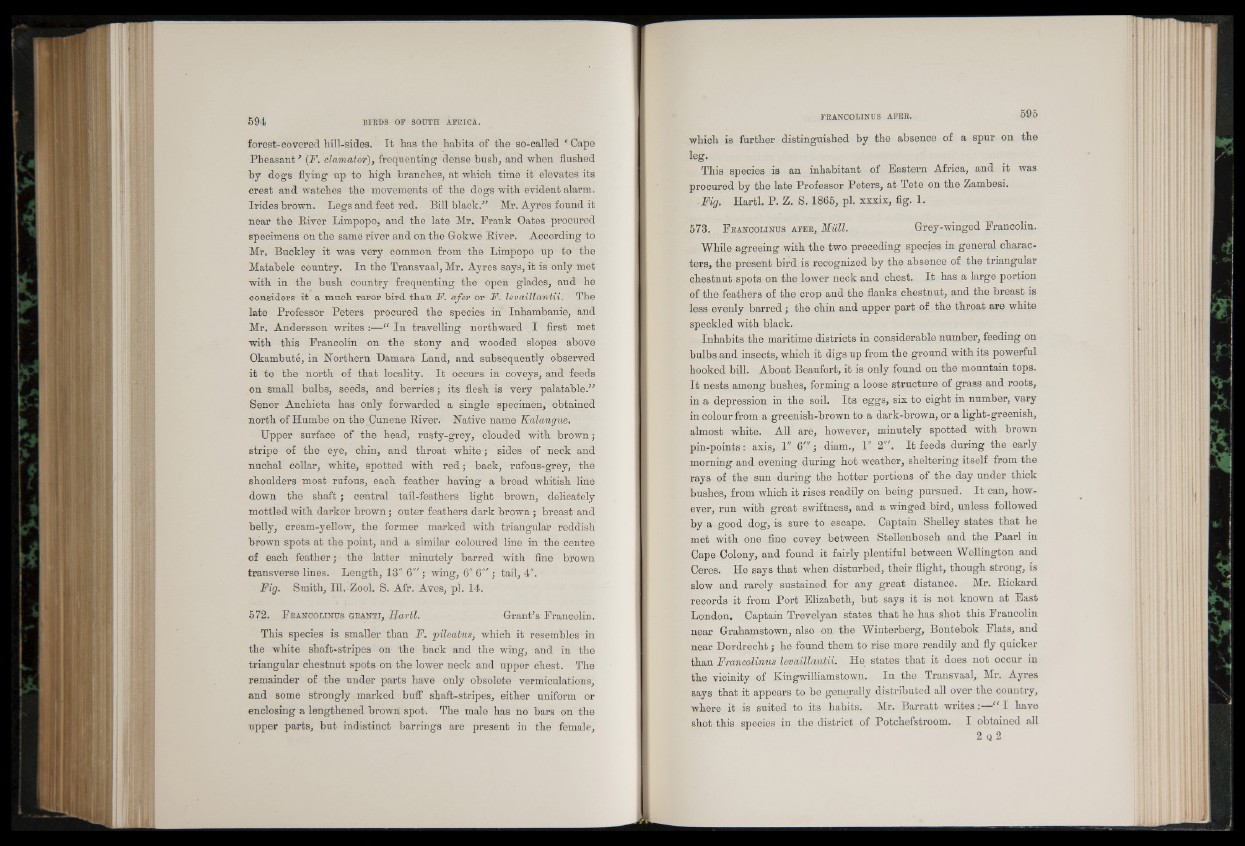
forest-covered hill-sides. It has the habits of the so-called ‘ Cape
Pheasant 5 (F. clnmator), frequenting dense bush, and when flushed
by dogs flying up to high branches, at which time it elevates its
crest and watches the movements of the dogs with evident alarm.
Irides brown. Legs and feet red. Bill black.” Mr. Ayres found it
near the River Limpopo, and the late Mr. Prank Oates procured
specimens on the same river and on the Gokwe River. According to
Mr. Buckley it was very common from the Limpopo up to the
Matabele country. In the Transvaal, Mr. Ayres says, it is only met
with in the bush country frequenting the open glades, and he
considers it a much rarer bird than F. afer or F. levaillantii. The
late Professor Peters procured the species in Inhambanie, and
Mr. Andersson writes :—“ In travelling northward I first met
with this Francolin on the stony and wooded slopes above
Okambute, in Northern Damara Land, and subsequently observed
it to the north of that locality. I t occurs in coveys, and feeds
on small bulbs, seeds, and berries; its flesh is very palatable/ 5
Senor Anchieta has only forwarded a single specimen, obtained
north of Humbe on the Cunene River. Native name Kalangue.
Upper surface of the head, rusty-grey, clouded with brown;
stripe of the eye, chin, and throat white; sides of neck and
nuchal collar, white, spotted with red ; back, rufous-grey, the
shoulders most rufous, each feather having a broad whitish line
down the shaft; central tail-feathers light brown, delicately
mottled with darker brown; outer feathers dark brown ; breast and
belly, cream-yellow, the former marked with triangular reddish
brown spots at the point, and a similar coloured line in the centre
of each feather;; the latter minutely barred with fine brown
transverse lines. Length, 13" 6'"; wing, 6" 6'"; tail, 4".
Fig. Smith, 111. Zool. S. Afr. Aves, pi. 14.
572. F r a n c o l in u s g r a n t i , Hartl. Grant5s Francolin.
This species is smaller than F. pileatus, which it resembles in
the white shaft-stripes on the back and the wing, and in the
triangular chestnut spots on the lower neck and upper chest. The
remainder of the under parts have only obsolete vermiculations,
and some strongly marked buff shaft-stripes, either uniform or
enclosing a lengthened brown spot. The male has no bars on the
upper parts, but indistinct barrings are present in the female,
which is further distinguished by the absence of a spur on the
leg.
This species is an inhabitant of Eastern Africa, and it was
procured by the late Professor Peters, at Tete on the Zambesi.
■ Fig. Hartl. P. Z. S. 1865, pi. xxxix, fig. 1.
573. F r a n c o l in u s a r e r , Müll. Grey-winged Francolin.
While agreeing with the two preceding species in general characters,
the present bird is recognized by the absence of the triangular
chestnut spots on the lower neck and chest. It has a large portion
of the feathers of the crop and the flanks chestnut, and the breast is
less evenly barred ; the chin and upper part of the throat are white
speckled with black.
Inhabits the maritime districts in considerable number, feeding on
bulbs and insects, which it digs up from the ground with its powerful
hooked bill. About Beaufort, it is only found on thé mountain tops.
I t nests among bushes, forming a loose structure of grass and roots,
in a depression in the soil. Its eggs, six to eight in number, vary
in colour from a greenish-brown to a dark-brown, or a light-greenish,
almost white. All are, however, minutely spotted with brown
pin-points : axis, 1" 6/7/ ; diam., 1" 2,,/. It feeds during the early
morning and evening during hot weather, sheltering itself from the
rays of the sun during the hotter portions of the day under thick
bushes, from which it rises readily on being pursued. I t can, however,
run with great swiftness, and a winged bird, unless followed
by a good dog, is sure to escape. Captain Shelley states that he
met with one fine covey between Stellenbosch and the Paarl in
Cape Colony, and found it fairly plentiful between Wellington and
Ceres. He says that when disturbed, their flight, though strong, is
slow and rarely sustained for any great distance. Mr. Rickard
records it from Port Elizabeth, but says it is not known at East
London. Captain Trevelyan states that he has shot this Francolin
near Grahamstown, also on the Winterberg, Bontebok Flats, and
near Dordrecht ; he found them to rise more readily and fly quicker
than Francolinus levailla/ntii. He states that it does not occur in
the vicinity of Kingwifliamstown. In the Transvaal, Mr. Ayres
says that it appears to be generally distributed all over the country,
where it is suited to its habits. Mr. Barratt writes :—“ I have
shot this species in the district of Potchefstroom. I obtained all
2 q 2